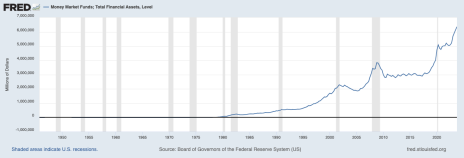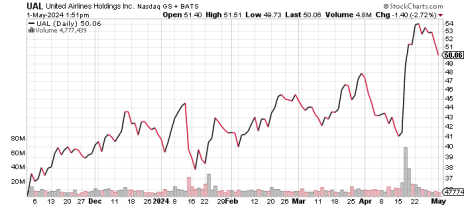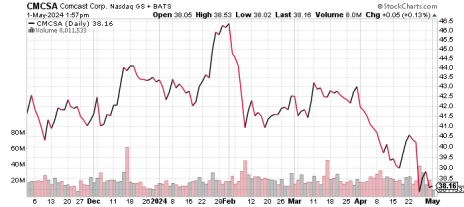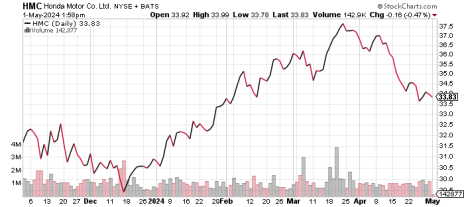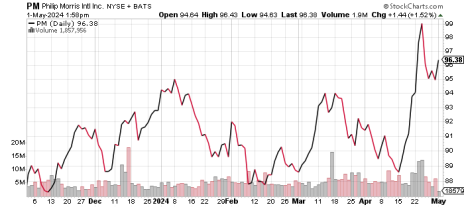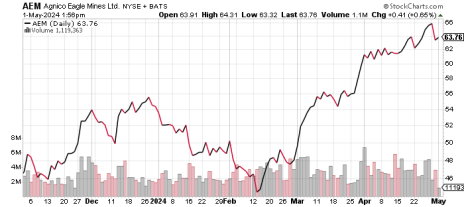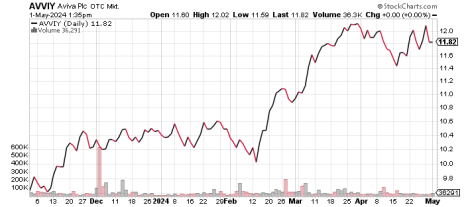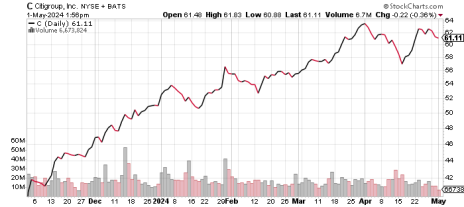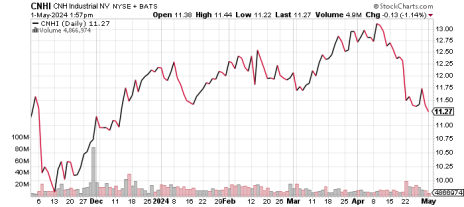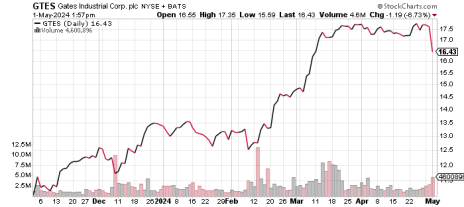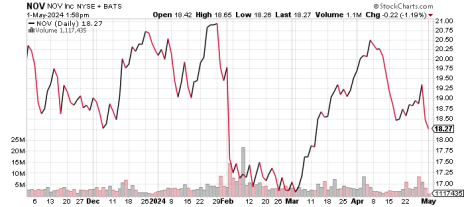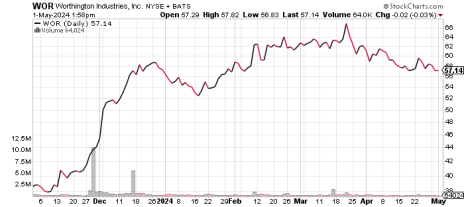Investor, Consumer Skepticism Remain
Going strictly by the numbers, the good times are rolling in both the U.S. economy and its stock markets.
U.S. GDP has expanded for seven straight quarters, corporate earnings are on track to expand for a third straight quarter, unemployment has been less than 4% for more than two years, and the S&P 500 is up nearly 19% in the last six months despite a down April. But those are numbers. Feelings tell a different story.
Consumer confidence is at a 21-month low. Persistent – the term du jour is “sticky” – inflation is the main concern, as CPI appears to have stagnated above 3% after falling precipitously from four-decade highs above 9%. Global strife, in Gaza and the Ukraine, and the impending presidential election are also giving consumers pause, according to the April survey, though those are secondary worries. Higher prices – and the high interest rates that have accompanied them – are still the dark cloud hanging over everything, and after two-plus years, it’s wearing on people.
That’s reflected in stocks too. Sure, we’re in a bull market, and prior to April the S&P was up five straight months starting last November – just its 30th five-month winning streak since 1950. But because of its heavy weighting toward the so-called “Magnificent Seven,” the S&P’s performance has become increasingly skewed toward a handful (or couple handfuls) of stocks.
More accurate gauges of what’s actually happening in the market are the Dow and the S&P Equal Weight Index, which weighs each of the 500 S&P stocks equally. That’s up a mere 2% year to date and is actually lower than it was at the end of 2021. And the Dow is essentially flat in 2024.
Furthermore, there’s just not much money in the stock market at the moment. Much of it is going to money market funds – a record $6.4 trillion was in money market funds as of the end of 2023, up $1.2 trillion from the prior year (chart below).
All of this is good news, in my mind. Once the Fed starts cutting interest rates – which won’t happen as soon as most economists anticipated at the start of the year (and didn’t again yesterday, with Jerome Powell and company electing to keep rates flat again), but it will happen as long as inflation doesn’t explode again – that record amount of cash on the sidelines will start to get deployed. And it will have nowhere to go but the stock market.
Of course, it may take a bit longer to restore consumer confidence, and Americans’ feelings about the state of the economy. Remember, consumer confidence soared to multi-year highs in 2021 and remained high until 2022 … when the bear market arrived. It started to perk up this past December and January, right after the Fed started talking about cutting rates in 2024 and stocks subsequently spiked to new highs.
It’s no fun being at the mercy of inflation readings and the Fed. But that’s where we’ve been these last couple years. Once those clouds part – say, if CPI dips below 3% and/or the Fed makes its first rate cut – those fears will begin to wane, and some of that $6.4 trillion money market fund cash will shift to the stock market, just as it did in 2003-04 after the fallout from the dot-com bubble burst, in 2009-10 (post-Great Recession), and in 2020-21 (post-Covid crash).
Until then, there are plenty of good value stocks out there. Even better, there’s growth at value prices. And today, we add another such stock to our Growth/Income Portfolio…
New Buy: United Airlines (UAL)
People are flying in planes again.
That would have been a weird sentence to type about five years ago. Then Covid happened, and for about two years, people around the world were afraid to travel – and particularly reluctant to travel in tight quarters for hours on end with little ventilation. So, the airlines suffered – all airlines.
In 2019, passenger numbers on U.S. airlines reached a record 926 million. In 2020, the number nose-dived to 371 million. It nearly doubled to 666 million in 2021, but that was still the second-lowest tally this century. But by 2022, passenger numbers had returned to “normal,” pre-Covid numbers: 852 million that year, 863 million last year. The number is expected to swell again this year, with Airlines for America projecting record early-spring (March-April) traveler numbers of 167 million, a 6% increase from the 157 million who traveled on U.S. airlines last March and April.
Internationally, the numbers are even more impressive. Global passenger numbers are expected to reach 4.7 billion this year, topping the 2019 record of 4.5 billion, according to the International Air Transport Association. That would mean a 7.6% bump in total revenues to $964 billion – also a record.
United Airlines is the fastest-growing major U.S. airline. The third-largest airline carrier in the world by revenues behind Delta (DAL) and American (AAL), United is expected to grow sales by 7.4% in 2024 – more than its two larger competitors – and that’s with revenues already topping a record $50 billion in 2023 – 19.6% higher than in 2022, which was also a record year. For United, business has not only returned to pre-pandemic levels; it’s better.
Meanwhile, the stock is cheap. It trades at a mere 5x forward earnings estimates, with a price-to-sales ratio of just 0.31 and a price-to-book value of 1.81. The stock peaked at 96 a share in November 2018; it currently trades at just a hair under 50 per share. And yet, the stock is having a good year, up 20%. In the last week, however, UAL shares have pulled back from 2024 highs above 54, giving us an even better entry point.
A company that’s making more money than ever before (gross profits reached a record $15.2 billion last year, though earnings were still second to 2019 levels on a per-share basis), and yet its stock trades at barely more than half its peak from five and a half years ago. That’s the definition of growth at a value price. (Note: United does not pay a dividend, so this addition solely satisfies the “growth” portion of our Growth/Income Portfolio.)
Let’s step in here, with a price target of 70 – 40% higher than the current share price. BUY
Note to new subscribers: You can find additional commentary on past earnings reports and other news on recommended companies in prior editions and weekly updates of the Cabot Value Investor on the Cabot website.
Send questions and comments to chris@cabotwealth.com.
This Week’s Portfolio Changes
United Airlines (UAL) – New Buy with a 70 price target
Last Week’s Portfolio Changes
None
Upcoming Earnings Reports
Thursday, May 2: CNH Industrial (CNHI)
Thursday, May 9: Honda Motor Co. (HMC)
Growth & Income Portfolio
Growth & Income Portfolio stocks are generally higher-quality, larger-cap companies that have fallen out of favor. They usually have some combination of attractive earnings growth and an above-average dividend yield. Risk levels tend to be relatively moderate, with reasonable debt levels and modest share valuations.
| Stock (Symbol) | Date Added | Price Added | 5/1/24 | Capital Gain/Loss | Current Dividend Yield | Price Target | Rating |
| Comcast Corp (CMCSA) | 10/26/22 | 31.5 | 38.17 | 21.20% | 3.20% | 46 | Hold |
| Honda Motor Co. (HMC) | 4/4/24 | 36.34 | 33.87 | -6.80% | 3.00% | 45 | Buy |
| Philip Morris International (PM) | 9/18/23 | 96.96 | 96.57 | -0.40% | 5.50% | 120 | Buy |
| United Airlines (UAL) | 5/2/24 | 50.01 | 50.01 | --% | N/A | 70 | Buy |
Comcast Corporation (CMCSA) – Comcast is one of the world’s largest media and entertainment companies. Its properties include Comcast cable television, NBCUniversal (movie studios, theme parks, NBC, Telemundo and Peacock), and Sky media. The Roberts family holds a near-controlling stake in Comcast. Comcast shares have tumbled due to worries about cyclical and secular declines in advertising revenues and a secular decline in cable subscriptions as consumers shift toward streaming services, as well as rising programming costs and incremental competitive pressure as phone companies upgrade their fiber networks.
However, Comcast is a well-run, solidly profitable and stable company that will likely continue to successfully fend off intense competition while increasing its revenues and profits, as it has for decades. The company generates immense free cash flow which is more than enough to support its reasonable debt level, generous dividend and sizeable share buybacks.
Comcast reported first-quarter earnings that beat estimates last Thursday. Adjusted earnings per share of $1.04 surpassed analyst projections of $0.99, while revenue ($30.06 billion) eked past expectations of $29.81 billion. Year-over-year growth was fairly modest at 0.6% EPS and 1.2% for revenue.
Broadband internet and cable subscriber numbers continue to bleed, although Comcast’s broadband segment got a boost after raising rates despite losing 65,000 customers during the quarter. It lost 487,000 cable customers. Theme park earnings were also down, at least on an EBITDA basis, with a 3.9% year-over-year decline, mostly due to higher marketing and promotion costs.
The bright spots were Comcast’s wireless segment (21% gain in customers, to 6.9 million total lines); its Peacock streaming service, which was the exclusive home of Oppenheimer, last year’s Best Picture winner at the Oscars and a box office hit. That, combined with the airing of an NFL Wild Card playoff game in January, helped bring in 3 million new Peacock subscribers, raising the total number to 34 million. But at $1.1 billion, it’s roughly 1/30th of total revenue.
This summer’s Olympics in Paris should help both Peacock and NBCUniversal, which will air the Games this July.
Still, investors have mostly focused on the negatives from the report, and CMCSA shares are down about 4.5%. The stock has 20% upside to our 46 price target. But given the recent weakness (it’s down more than 12% year to date), I’m keeping our rating at Hold. HOLD
Honda Motor Co. (HMC) – After years of declining sales, Honda was rejuvenated in 2023 thanks to hybrids. The Japanese automaker sold 1.3 million cars last year, up 33% from 2022; a quarter of the cars it sold were hybrids, led by its popular CR-V sport utility vehicle (SUV) and Accord mid-size sedan. The CR-V was the best-selling hybrid in the U.S. last year, with 197,317 units sold. The Accord wasn’t far behind, with 96,323 sold. All told, Honda’s hybrid sales nearly tripled in 2023, to 294,000 units.
So, Honda is making the full pivot to hybrids, with the Civic soon to become the latest addition to its hybrid fleet. Investors have started gravitating more to the companies that sell them. Invariably, those are well-established, big-name car companies made famous by many decades of selling internal combustion engine vehicles; most aren’t ready to fully abandon their roots but want to tap into the surging national (and global) appetite for electric, so they instead are turning to hybrids as a compromise. As a result, these once-stodgy car companies are tapping into new revenue streams, and their share prices are surging accordingly.
Among the hybrid-rejuvenated, brand-name automakers, Honda offers the best value.
There was no company-specific news for Honda this week.
Honda shares are down another 1.7% since we last wrote and remain dirt-cheap at 7.8x earnings and with a price-to-sales ratio of 0.46. The company reports earnings a week from today, May 9. Perhaps that can stop the recent bleeding, especially given how strong revenues have been growing of late thanks in large part to the Japanese automaker’s booming hybrid sales.
The stock has 33% upside to our 45 price target. BUY
Philip Morris International (PM) – Based in Connecticut, Philip Morris owns the global non-U.S. rights to sell Marlboro cigarettes, the world’s best-selling cigarette brand. Cigarettes comprise about 65% of PMI’s revenues. The balance of its revenues is produced by smoke-free tobacco products. The cigarette franchise produces steady revenues and profits while its smoke-free products are profitable and growing quickly. The upcoming full launch of IQOS products in the United States, a wider launch of the IQOS ILUMA product and the recent $14 billion acquisition of Swedish Match should help drive new growth.
The company is highly profitable, generates strong free cash flow and carries only modestly elevated debt (at about 3.2x EBITDA) which it will whittle lower over the next few years. The share valuation at about 14x EBITDA and 14.3x per-share earnings estimates is too low in our view. Primary risks include an acceleration of volume declines and/or deteriorating pricing, higher excise taxes, new regulatory or legal issues, slowing adoption of its new products, and higher marketing costs. A strong U.S. dollar will weigh on reported results. While unlikely, Philip Morris could acquire Altria, thus reuniting the global Marlboro franchise.
There was no company-specific news for Philip Morris this past week. The company is coming off an encouraging earnings report the week before. Adjusted EPS of $1.50 outpaced analyst estimates of $1.41 per share, while revenues improved 11% year over year. There was a clear driver behind the sales growth: Zyn. That’s the company’s nicotine pouch; it sold 131.6 million cans of Zyn in Q1, a whopping 80% improvement from the first quarter a year ago. Zyn’s share of the nicotine pouch market is now up to 74%. Another contributor to Philip Morris’ strong quarter was its heated tobacco device IQOS, which is expected to launch in the U.S. in the second quarter. Global shipments of IQOS units grew by 21% to 33.1 billion in the quarter.
After getting a nice 7% bump following the earnings report last week, PM shares came back down to earth a tad this week, falling 1.6%. Still, the stock is up from 88 to 96 since mid-April, and yet has 25% upside to our 120 price target. The 5.5% dividend yield adds to the appeal. BUY
Buy Low Opportunities Portfolio
Buy Low Opportunities Portfolio stocks include a wide range of value opportunities. These stocks carry higher risk than our Growth & Income stocks yet also offer more potential upside. This group may include stocks across the quality and market cap spectrum, including those with relatively high levels of debt and a less clear earnings outlook. The stocks may not pay a dividend. In all cases, the shares will trade at meaningful discounts to our estimate of fair value.
| Stock (Symbol) | Date Added | Price Added | 5/1/24 | Capital Gain/Loss | Current Dividend Yield | Price Target | Rating |
| Agnico Eagle Mines (AEM) | 3/25/24 | 56.31 | 64.35 | 14.20% | 2.50% | 75 | Buy |
| Aviva (AVVIY) | 3/3/21 | 10.75 | 11.82 | 10.00% | 7.00% | 14 | Buy |
| Citigroup (C) | 11/24/21 | 67.28 | 61.31 | -8.90% | 3.40% | 85 | Buy |
| CNH Industrial (CNHI) | 11/30/23 | 10.74 | 11.34 | 5.60% | 4.10% | 15 | Buy |
| Gates Industrial Corp (GTES) | 8/31/22 | 10.72 | 16.33 | 52.30% | N/A | 20 | Buy |
| NOV, Inc (NOV) | 4/25/23 | 18.19 | 18.33 | 0.80% | 1.60% | 25 | Buy |
| Worthington Enterprises (WOR) | 2/6/24 | 57.13 | 57.44 | 0.50% | 1.10% | 73 | Buy |
Agnico Eagle Mines (AEM) is the world’s third-largest and likely the highest-quality and lowest-risk gold mining company. Its strategy of “proven geological potential in premier jurisdictions” appropriately describes its exclusive focus on quality mines in the legally safe countries of Canada, Mexico, Australia and Finland. In the past few years, Agnico has made several in-region acquisitions including Kirkland Lake in 2022 for $11 billion and Yamana Gold’s Canadian assets for $2.6 billion. The plan for the next five years is to fully integrate and improve these operations and grow production in its existing mines.
As the owner of some of the industry’s highest-quality mines, Agnico has production volumes that look steady for years to come. While some of its ten major mines will see tapering output, nearly all of the others will have steady increases, driven by continued investment and exploration. Agnico’s gold reserves are high quality and increased 11% last year, supporting its outlook for at least stable production volumes. In 2023, the company’s production came in at the high end of its guidance range.
Agnico continues to be an efficient operator, with all-in sustaining costs (or AISC) of about $1,200/ounce, which is roughly 12% below the industry average. Helping its economics are the quality of its mines, the close geographic proximity of its Ontario and Quebec mines and the surplus capacity in its Detour Lake facility that will allow for higher throughput with minimal incremental costs.
We see in Agnico a well-managed company that meets/exceeds its production and cost guidance yet has shares that are noticeably undervalued.
Agnico reported strong first-quarter results last Thursday, with revenues up 21% and EPS up 33% year over year with gold prices spiking to all-time highs of late. Both figures handily beat analyst estimates. Also, the gold miner ended the quarter with cash and cash equivalents of $524.6 million, up 55%, while total cash from operating activities reached $783.2 million, up from $649.6 million a year ago.
AEM shares are up marginally since the report, as many of the gains may have already been baked in with the stock up 40% since mid-February. Still, shares have 18% upside to our 75 price target. BUY
Aviva, plc (AVVIY), based in London, is a major European company specializing in life insurance, savings and investment management products. Amanda Blanc, hired as CEO in July 2020, is revitalizing Aviva’s core U.K., Ireland and Canada operations following her divestiture of other global businesses. The company now has excess capital which it is returning to shareholders as likely hefty dividends following a sizeable share repurchase program. While activist investor Cevian Capital has closed out its previous 5.2% stake, highly regarded value investor Dodge & Cox now holds a 5.0% stake, providing a valuable imprimatur and as well as ongoing pressure on the company to maintain shareholder-friendly actions.
There was no company-specific news this past week.
AVVIY shares were up 2% since our last issue. The stock has 17% upside to our 14 price target. The 7.1% dividend yield is a nice cherry on top of the 9% gain in the share price this year. BUY
Citigroup (C) – Citi is one of the world’s largest banks, with over $2.4 trillion in assets. The bank’s weak compliance and risk-management culture led to Citi’s disastrous and humiliating experience in the 2009 global financial crisis, which required an enormous government bailout. The successor CEO, Michael Corbat, navigated the bank through the post-crisis period to a position of reasonable stability. Unfinished, though, is the project to restore Citi to a highly profitable banking company, which is the task of new CEO Jane Fraser. Investors have lost hope in Citigroup, creating an impressive bargain.
There was no major company-specific news for Citigroup this week, though the bank reported strong quarterly earnings last month. Revenue came in at $21.1 billion, ahead of $20.4 billion expected. Earnings per share of $1.86 blew away analyst estimates of $1.23. However, EPS was down 27% from last year’s first-quarter tally due to higher expenses and credit costs. Revenue was also down, about 2% year over year, but it was only down compared to a first quarter last year in which the bank sold an overseas business.
The highlight was Citi’s investment banking unit, which saw a 35% revenue bump on the strength of a solid Q1 for the market.
Investors initially sold out of C after the report but have since come around, and the stock is up about 7% since a mid-April bottom at 57, though it did give back about 2.5% of its gains in the last week. C shares trade at less than 11x earnings and at 1.5x sales. BUY
CNH Industrial (CNHI) – This company is a major producer of agriculture (80% of sales) and construction (20% of sales) equipment and is the #2 ag equipment producer in North America (behind Deere). Its shares have slid from their peak and now trade essentially unchanged over the past 20 years. While investors see an average cyclical company at the cusp of a downturn, with a complicated history and share structure, we see a high-quality and financially strong company that is improving its business prospects and is simplifying itself yet whose shares are trading at a highly discounted price. See our November 30 Alert and the December 5 Monthly letter for more commentary on our thesis.
There was no company-specific news about CNH ahead of today’s (May 2) earnings report. Expectations are low (-15% revenue, -19% EPS) so perhaps the actual results can clear a low bar.
Shares were down 1% ahead of the report and are coming off a rough April in which they fell from 13 to 11 on no particular news. The stock has 24% upside to our 14 price target. The 4.1% dividend yield helps ease the recent slide. BUY
Gates Industrial Corp, plc (GTES) – Gates is a specialized producer of industrial drive belts and tubing. While this niche might sound unimpressive, Gates has become a leading global manufacturer by producing premium and innovative products. Its customers depend on heavy-duty vehicles, robots, production and warehouse machines and other equipment to operate without fail, so the belts and hydraulic tubing that power these must be exceptionally reliable. Few buyers would balk at a reasonable price premium on a small-priced part from Gates if it means their million-dollar equipment keeps running. Even in automobiles, which comprise roughly 43% of its revenues, Gates’ belts are nearly industry-standard for their reliability and value. Helping provide revenue stability, over 60% of its sales are for replacements. Gates is well-positioned to prosper in an electric vehicle world, as its average content per EV, which require water pumps and other thermal management components for the battery and inverters, is likely to be considerably higher than its average content per gas-powered vehicle.
The company produces wide EBITDA margins, has a reasonable debt balance and generates considerable free cash flow. The management is high-quality. In 2014, private equity firm Blackstone acquired Gates and significantly improved its product line-up and quality, operating efficiency, culture and financial performance. Gates completed its IPO in 2018. Following several sell-downs, Blackstone has a 27% stake today.
Gates narrowly beat earnings estimates yesterday, but Wall Street didn’t like the mixed results.
The 31-cent EPS outpaced analyst estimates of 30 cents and was up 20% from the 25 cents it earned in the first quarter a year ago. However, sales of $862.6 million even more narrowly missed analyst estimates and, more importantly, represented a 3.9% decline from the $897.7 million in revenue from Q1 a year ago.
Management has not held its earnings call as of this writing, so the 8-K filing is all we have so far. With no words to provide context for the rather underwhelming sales numbers, GTES shares were down more than 7% on Wednesday. Mind you, they had been trading near 52-week highs for weeks prior to earnings, so the 7% retreat is not overly damaging.
Shares now have 23% upside to our 20 price target. BUY
NOV, Inc (NOV) – This high-quality, mid-cap company, formerly named National Oilwell Varco, builds drilling rigs and produces a wide range of gear, aftermarket parts and related services for efficiently drilling and completing wells, producing oil and natural gas, constructing wind towers and kitting drillships. About 64% of its revenues are generated outside of the United States. Its emphasis on proprietary technologies makes it a leader in both hardware, software and digital innovations, while strong economies of scale in manufacturing and distribution as well as research and development further boost its competitive edge. The company’s large installed base helps stabilize its revenues through recurring sales of replacement parts and related services.
We see the consensus view as overly pessimistic, given the company’s strong position in an industry with improving conditions, backed by capable company leadership and a conservative balance sheet.
NOV reported earnings last Wednesday that were fairly mixed. Revenues improved 10% year over year (better than the 7.7% top-line growth that was expected), but EPS declined 5.6%, far less than the 15% shortfall that was estimated. However, with operating profits and adjusted EBITDA improved, the company plans to return more cash to shareholders: $1 billion in share repurchases over the next three years, and a 50% hike in the dividend payout starting this June. The driller currently pays a 30-cent (1.6% yield) annual dividend.
NOV shares are down about 2% since the earnings report. The stock has 31% upside to our 24 price target. BUY
Worthington Enterprises (WOR) – Following the split-up of Worthington Industries late last year, “Enterprises” focuses on producing specialized building products (42% of sales) and consumer products (48%). The value of these operations was previously obscured by the market’s perception that the original Worthington Industries was primarily a steel processor. While the market sees an average company with a mix of only partly related products, we see a high-quality company with strong positions in valuable and profitable niches, backed by capable management and a solid balance sheet.
There was no company-specific news this past week.
WOR shares were down 2% this week and are still shaking off the cobwebs from a disappointing earnings report in late March. Revenues were down 9% in the company’s fiscal third quarter, while earnings per share declined 1%. Wall Street understandably didn’t love the results, though EPS did come in 16% ahead of consensus estimates, and both gross margins and adjusted EBITDA margins ticked up slightly.
The stock has 27% upside to our 73 price target. BUY
The next Cabot Value Investor issue will be published on June 6, 2024.
Copyright © 2024. All rights reserved. Copying or electronic transmission of this information without permission is a violation of copyright law. For the protection of our subscribers, copyright violations will result in immediate termination of all subscriptions without refund. Disclosures: Cabot Wealth Network exists to serve you, our readers. We derive 100% of our revenue, or close to it, from selling subscriptions to our publications. Neither Cabot Wealth Network nor our employees are compensated in any way by the companies whose stocks we recommend or providers of associated financial services. Employees of Cabot Wealth Network may own some of the stocks recommended by our advisory services. Disclaimer: Sources of information are believed to be reliable but they are not guaranteed to be complete or error-free. Recommendations, opinions or suggestions are given with the understanding that subscribers acting on information assume all risks involved. Buy/Sell Recommendations: are made in regular issues, updates, or alerts by email and on the private subscriber website. Subscribers agree to adhere to all terms and conditions which can be found on CabotWealth.com and are subject to change. Violations will result in termination of all subscriptions without refund in addition to any civil and criminal penalties available under the law.
